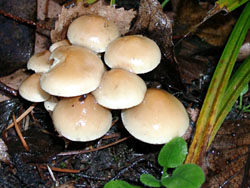Conifer tuft (Hypholoma capnoides)

Conifer tuft
The conifer tuft is native to Central Europe.
Important information on this mushroom: there are several wild mushrooms with a similar appearance which are not edible, such as the brick cap (Hypholoma lateritium) or the sulphur tuft (Hypholoma fasciculare). They have green or yellow lamellae (or gills) and should not be eaten!
The conifer tuft grows well on stumps of spruce or pine, and occasionally beech too and can also be used to decompose coniferous stumps in the garden. it is also possible to inoculate Douglas fir.
Profile of the conifer tuft |
Taste and preparation:
A tasty forest mushroom. As with many small mushrooms growing in bunches or clusters, it can be a bit difficult to clean before cooking, but the effort is worth it |
Production and marketing:
We have not found this mushroom in the marketplace. |
Growing in the garden:
Grows well on coniferous wood and can be used to accelerate the decomposition of coniferous stumps. Grows reliably. Several harvests a year, above all in early Autumn. |
Our products:
Grain spawn for conifer tuft mushrooms |
|